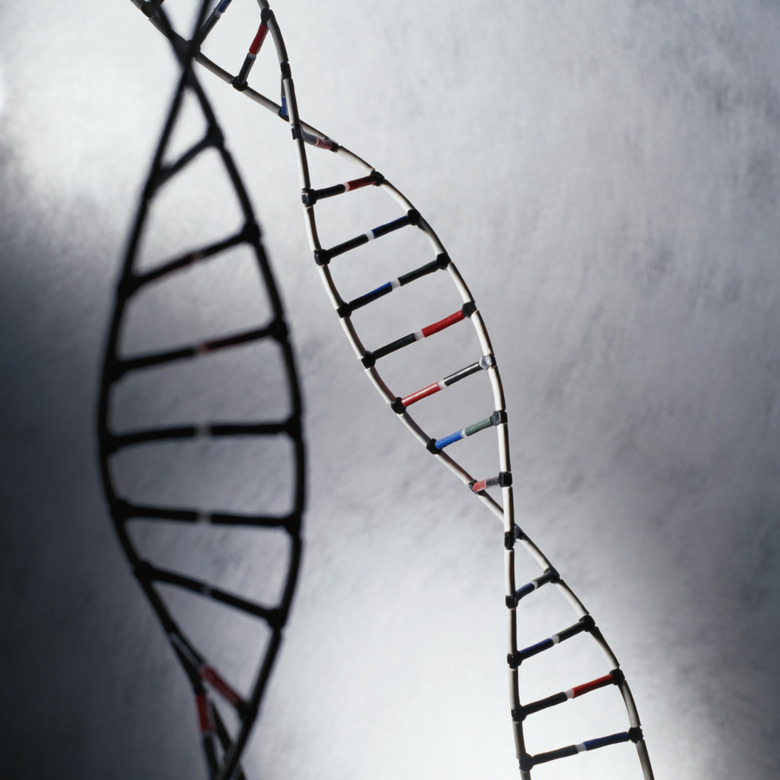What Must Happen To The DNA Strands In The Nucleus Before The Cell Can Divide?
Before a cell divides, the strands of DNA in the nucleus must be copied, checked for errors and then packaged into neat finger-like structures. The cell division stages encompass a complicated process that involves many changes inside the cell. Many proteins unwind DNA in order to copy it, which makes it vulnerable to breakage. During cell division, DNA is pulled to and fro, which can cause it to break if it is not carefully packaged.
The Cell Cycle: Synthesis and Cell Division Stages
The Cell Cycle: Synthesis and Cell Division Stages
Cell division, or mitosis, is part of the cell cycle. The cell has a preparation phase called interphase and a division phase called the M phase. The M phase in turn consists of mitosis and cytokinesis, the splitting of the cell onto daughter cells. The four classic mitosis phases are prophase, metaphase, anaphase and telophase. Together, these result in the formation of identical daughter nuclei.
The preparation phase, interphase, has three smaller phases within it, called **G1, S** and **G2.** The G1 (first gap) phase is when the cell grows by making more protein. The S (synthesis) phase is when it copies its DNA so that it has two copies of each strand, which are called _chromosomes_. G2 (second gap) phase is when the cell makes a copy of its organelles and checks the DNA for errors before starting the process of cell division.
When the DNA is copied in the S phase, the resulting identical strands are called sister chromatids. In humans, after the copying is complete, the cell has two full copies of all 46 of its chromosomes, 23 each from the mother and from the father. But in mitosis, the similar numbered chromosomes from each parent, called homologous chromosomes, do not physically associate.
DNA Synthesis
DNA Synthesis
In preparation for cell division, the cell makes a replica of its entire DNA. This happens during the S, or synthesis, phase of the cell cycle. Mitosis is the division of one cell into two cells that each has a nucleus and the same amount of DNA as the original cell. DNA synthesis is a complicated process that makes the DNA vulnerable to breaking since the DNA needs to be unpacked and unwound into its simplest form. S phase also requires a lot of energy molecules. It is such a big commitment that the cell reserves a separate phase for it.
DNA Packaging
DNA Packaging
The strands of DNA inside the nucleus of a cell must be packaged into short, thick, finger-like X shapes. DNA does not exist by itself but rather is wrapped around proteins and by proteins so that it forms a mixture of DNA and protein called chromatin. DNA is like a long garden hose that can be wound and twirled into a cylindrical stack, called a condensed chromosome.
This tight packing makes DNA stronger and more resistant to breaking. Condensed chromosomes have strong regions called centromeres, which are like belts that can be pulled on to move chromosomes from place to place within a cell.
Checking for Breaks
Checking for Breaks
After making a copy of all DNA strands, the cell must check the DNA for any breaks before starting mitosis. This happens during the G2 phase of the cell cycle. The cell has protein machines that can detect breakages in DNA. If any problems are found, the DNA damage response proteins stop the cell from moving forward in the process mitosis until the DNA is fixed. In order to start mitosis, the cell must pass what is called the **G2-M checkpoint**. This is the last time that a cell in the G2 phase can stall for repairs before starting mitosis.
Cite This Article
MLA
Ph.D., David H. Nguyen,. "What Must Happen To The DNA Strands In The Nucleus Before The Cell Can Divide?" sciencing.com, https://www.sciencing.com/must-happen-dna-strands-nucleus-before-cell-can-divide-23163/. 31 July 2019.
APA
Ph.D., David H. Nguyen,. (2019, July 31). What Must Happen To The DNA Strands In The Nucleus Before The Cell Can Divide?. sciencing.com. Retrieved from https://www.sciencing.com/must-happen-dna-strands-nucleus-before-cell-can-divide-23163/
Chicago
Ph.D., David H. Nguyen,. What Must Happen To The DNA Strands In The Nucleus Before The Cell Can Divide? last modified March 24, 2022. https://www.sciencing.com/must-happen-dna-strands-nucleus-before-cell-can-divide-23163/
